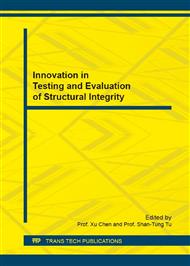p.83
p.88
p.92
p.96
p.101
p.106
p.112
p.117
p.122
Study on 3D Edge Crack Extension Simulation in Cold Rolling with the Cohesive Zone Model
Abstract:
In the cold rolling process, the edge crack extension can cause the strip rupture completely due to the micro manufacturing defects in the edge. It can greatly impact on the production efficiency and cause the huge economic loss. Thus predicting the edge crack extension behavior becomes important to cold rolling industry. In this paper, a 3D extended finite element method (XFEM) based on the cohesive zone model (CZM) was used to study the edge crack extension under the non-reversing two-high mill cold rolling experiment condition. A bi-linear traction-separation law was utilized which is primarily given by the CZM parameters including the cohesive stress, T0 and the cohesive energy, Γ0. The cohesive stress was determined by hybrid technique of the thin-plate tension test and FEM simulation. The cohesive energy was obtained by the In-Situ SEM three points bending experiment. Different reductions were the mainly analysis factor which can study the extent of the edge crack extension by presetting the edge notch. By comparing the experimental and simulation results, they agreed well with each other. It illustrated that the CZM can provide accurate predictions for the edge crack extension in the cold rolling process. Parametric analysis was carried out and showed that the extent of the crack extension increases with the increasing of the reduction ratio.
Info:
Periodical:
Pages:
101-105
Citation:
Online since:
September 2016
Authors:
Price:
Сopyright:
© 2017 Trans Tech Publications Ltd. All Rights Reserved
Share:
Citation:


